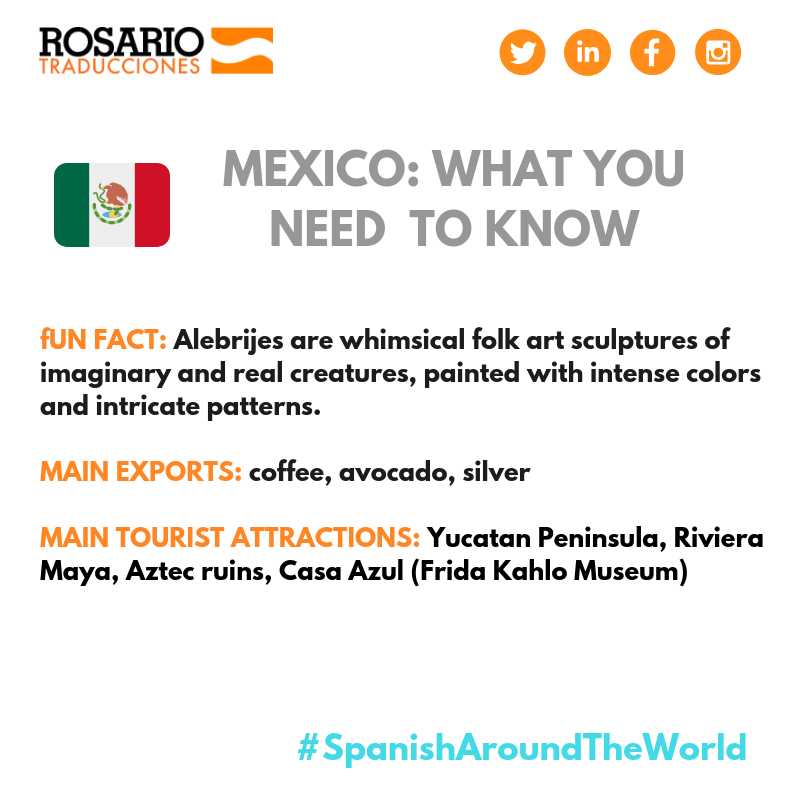10 FUN FACTS ABOUT MEXICO, A DIVERSE AND MULTICULTURAL LAND
For the launch of our new website section #SpanichAroundTheWord, we chose the largest Spanish-speaking country on the planet: Mexico.
At Rosario Traducciones y Servicios SA, we invite you to join us on a virtual tour through the different countries of Latin America, as we explore their diversity and cultural riches. In this first post, you will discover ten fun and unique facts about Mexico, the largest Spanish-speaking country in the world.
1) Mexico: extensive, diverse and multicultural
Mexico is the 11th most populous country on the planet, with almost 125 million inhabitants. Its capital city, the fifth largest in the world, is home to 30 million people. In addition to Spanish, 69 indigenous languages languages are spokes, along with their respective dialects. Mexico is one of the most linguistically diverse countries in the world, with the largest number of speakers of Amerindian languages in the Americas.
2) The capital with the largest number of museums
Mexico City tops the list of cities ith the highest number of museums. There are 171 museums, according to the Ministry of Tourism. However, there are reportedly more than 200, many of which are not officially registered.
3) Gastronomy: World Intangible Cultural Heritage
Mexican cuisine is so delicious and varied that it is recognized by the UNESCO as an intangible cultural heritage contribution to humanity. Mexico introduced chocolate, chili and corn to the rest of the world, and today, nachos with guacamole can be enjoyed even in the most remote places. Its flavors are as exotic as they are rich and diverse. For example, nopales (cactus leaves with spines) are eaten in salads, as are escamoles or chapulines, which are ant eggs and crickets, respectively.
4) A sinking capital
Mexico City was built on the ruins of the Aztec city Tenochtitlan. Today, the city sprawls beyond the space once occupied by Texcoco Lake, an acquirer that supplies 70% of all the water consumed in Mexico City. As a result, the Mexican capital is sinking 25 centimeters on average per year, a fact that is evident in some of the city’s largest buildings.
5) The largest pyramid in the world
Many believe that the largest pyramid is found in Egypt. However, Mexico's Great Pyramid of Cholula is the largest pyramid known to exist in the world, and the largest constructed monument still standing today. But Mexico is also a nation of contrasts. The ancient Aztec empire is home to the smallest volcano in the world, the Cuexcomate, an inactive geyser.
6) Latin American Capital of Guinness Records
Mexico City is the Latin American city with the highest number of Guinness records (approximately 400). These include the largest number of naked people (photographed by Spencer Tunick); the largest number of people dancing to Michael Jackson's Thriller at the same time; the largest number of people kissing simultaneously; the largest enchilada in the world; the cup of biggest mug of hot chocolate; and the largest altar of the Day of the Dead, to mention a few examples.
7) The largest park in Latin America
Chapultepec, or "Bosque de Chapultepec" (Chapultepec Forest) in Mexico City, is the largest city park in Latin America and one of the largest in the Western Hemisphere. Covering 678 hectares, it is twice the size of New York City's Central Park.
8) Coral riches
The natural wonders along the Riviera Maya are as extensive as its long white-sand beaches and as abundant as the cenotes or sink holes, which the Mayan people held sacred because they were once the only source of freshwater in the Yucatan jungle. It is also home to the second largest coral reef in the world (2,500 km), surpassed only by Australia's Great Barrier Reef (2,300 Km).
9) Day of the Dead Celebration
El Día de los Muertos (or Day of the Dead), a national holiday in Mexico, is celebrated on the 1st and 2nd of November. Over the course of two days, mexican families pay tribute to their departed loved ones in a celebratory manner.
This celebration dates back more than 3,000 years to the Aztecs, who paid homage to the souls of the deceased who visited the world of the living each year in November.
In this tradition, there are several types of altars, with different levels. An altar represents the material and immaterial world. Two-level altars represent the sky and the earth, and three-level altars symbolize the sky, the earth and the underworld. Sugar skulls, considered the favorite food of the spirits, and the bread of the dead (symbolizing the human sacrifices of ancient populations) are also part of the rituals.
In 2008, UNESCO recognized the importance of Día de los Muertos by adding the holiday to its list of Intangible Cultural Heritage of Humanity.
10) Great biological diversity
Mexico is one of the 18 most megadiverse countries of the world. To qualify, a country must have at least 5,000 species of endemic plants and border a marine ecosystem; in Mexico's case, it is believed that more than 200,000 species of plants and animals coexist in one of the the richest biologically diverse nations on the planet.

.png)
.png)




